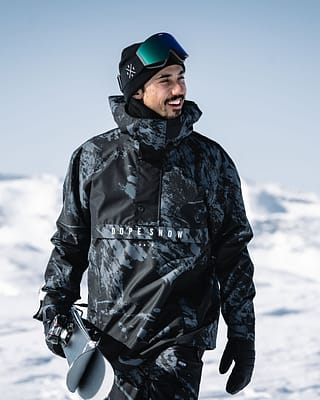How to store your winter clothes (and your ski or snowboard gear)
Winter’s over, and the long wait until next season has begun. But how do you store your winter gear properly? Read on to find out.

When the season comes to an end and you’ve got to pack up all your snow gear (yeah, it makes us sad, too), believe it or not, there’s a right and wrong way to do this. Do it wrong and your clothes can come out smelly, creased, and even mouldy (yuck!). So for our top tips on how to store your winter clothes properly, check out the article below.
5 clever tips for storing winter clothes
Five quick and dirty tips to help keep your snow gear in ride-ready shape. Who’s looking forward to opening day?

1. Pick the right storage spot
In a suit carrier in a wardrobe, or folded in a suit carrier or box, away from direct sunlight, and dust! Make sure your gear is safe and protected from the open air and abrasion. We don’t want your DWR rubbing off, now do we?
2. Store without creasing
Hard creases can cause weakness in the membrane or DWR over time, which is why it’s important not to have your snow gear crushed under anything or vacuum sealed while in storage. Hanging is the best way to remove existing creases and prevent future damage. And if you can’t hang them up, fold loosely in box or bag.
3. Wash and clean clothes before storage
If it smells going in, it’s going to stink coming out! Storing wet and dirty clothes will allow mould, bacteria, and even fungus to develop. This means when it’s time to pull them out again, you’ll be more pumpkin than Cinderella!
4. Repair broken clothes before storage
Tell yourself you’ll fix it next season is a great way to end up with a broken jacket on day one of your holiday! Fix any issues or damage before storing because it always seems like a bigger job when you discover them six months later.
5. Use storage bags / storage containers to keep dust and bugs off
Dust may not seem like a big deal, but it can get into and degrade the DWR coating. And if it doesn’t, wiping it off can do that. And sometimes, dust-mites can get into your clothes if they’re dusty. So yeah, dust bad, no dust good.
How to prepare winter clothes for storage

When you’re preparing winter clothes for storage, the most important thing to ensure is that they’re clean and dry. And that there’s no chocolates left in the pockets. Trust us, year-old, half-eaten Kit-Kats… Well, let’s just say they’re not still edible. Ahem, anyway, ensuring your clothes are clean and dry is priority number one. Wet or damp clothes will produce mould over the course of time and will make your gear stink, as well as affect the physical makeup and appearance of the item, too. Waterproofing, colour, they could all be ruined.
And if your clothes are dirty, either smelly from sweat or actually dirty, leaving them for a year will deeply ingrain any dirt into the fabric to the point where it will be nearly impossible to remove it without damaging the garment! So how do you do this?
How to clean winter clothes before storing?
Cleaning winter clothes can be a tricky thing with so many different methods out there! Our first recommendation is to check the labels and follow any washing instructions there.
However, a lot of the time, leaving your clothes to hang outside will rid them of any smells and let them dry out completely (providing it’s not raining!). If they’re particularly stinky, turn them inside out before allowing to air. You can also leave them outside in the rain while inside out which will help cleanse them!
Failing that, a light wash on a cold setting in the machine with a waterproof-garment safe washing detergent will definitely do the trick. Just remember not to spin them! We have a whole guide on washing here, if you need it.
How to dry winter clothes before storing?
If your snow gear is coming out of the wash sopping wet, allow to hang-dry inside over a bucket or tray until it’s drip free, then turn it inside out, and allow to hang dry in the open air outside until completely dry. The outer shell should dry quickly anyway, so once the lining and insulation is dry, you can turn it inside out and bring it in again, or leave it outside… Just make sure it’s not in direct sunlight if you are!
Once dry, tumble dry any DWR treated garments on medium heat for 20-30 minutes to reactivate the DWR layer and improve waterproofing ready for the coming season.
How can I safely store winter gear?
We recommend hanging your snow and winter gear up where possible. The best way to do this is to put your jacket and pants on a suit hanger inside a suit carrier/bag, which will keep it dust-free and protected from abrasion until it’s time for the next ride. But what if this isn’t possible?
How to fold if hanging isn’t possible?
Many people don’t have the kind of closet space necessary for this kind of storage. In that case, the best option you have is to fold loosely and place inside a storage box or crate! If you don’t have one, a suit carrier and hanger works brilliantly, too, lightly folded over. The main thing you want to avoid is continued exposure to dust (and the potential for dust-mites and/or moths!), direct sunlight, or other things which can affect the clothing over a long period of time.
So long as they’re covered, and not being squashed down by anything, folding is just as safe as hanging while you store your gear.




Storing skiing & snowboarding gear
When it comes to storing skiing and snowboard gear, you can use the tips above, but it’ll also be good to cover some ski and snowboard specific things!
Storing a ski jacket
A ski jacket should be stored in the same way a winter jacket should. Zip it up, make sure everything’s clean and dry, and then hang dry or fold loosely in a box, out of direct sunlight. This should keep your jacket ready to go for opening day.
Storing ski pants
Ski pants are no different, and can be hung up on a suit hanger, or folded and put in a box to keep them in top condition. Just don’t put anything heavy on top to avoid creases, and make sure all the pockets are zipped up, as well as ensuring that any belts or buckles aren’t pressing into the fabric when you store it.

Storing skiing accessories (goggles, etc)
All your extra gear, like goggles, gloves, helmets, anything like that, can all be kept in a box, and should be stored in whatever storage bags they came with. Goggles are the most fragile so should be put in a case or microfibre bag to protect them from your other gear. Helmets, as you can imagine, are a little tougher! But still, not cramming everything into one box will go a long way!
Storing ski or snowboard boots
Ski and Snowboard boots are super easy to store. We recommend making sure they’re very well dried and aired before storing, and kept somewhere safe and again, out of direct sunlight. Some people say to store them without the liners in, but we see no benefit for this, so just keep them in a boot bag, box, or somewhere they can sit quietly until next year.
Storing winter clothes FAQ’s
Can winter clothes be stored in a garage or attic?
Yes! Winter clothes can be stored anywhere that has a stable temperature, is damp and moisture free, and is clean. While a wardrobe is best, an attic or garage will do, providing your clothes are protected. A cardboard box just won’t cut it though! Get a sealed storage crate if you’re storing your clothes somewhere like this, so they remain in the best condition.
What is the best way to store winter clothes?
Hanging inside the house, in a suit carrier or bag inside your wardrobe. That’s the best way! Otherwise, a sealed box, somewhere clean and dry, out of direct sunlight. Don’t put anything heavy on your winter gear, and don’t vacuum seal for the best results and garment longevity.

Should I hang or fold winter clothing?
Either is fine, providing you make sure that it’s clean, dry, and protected from dust and direct sunlight, as well as creases and abrasion.
How do you store winter clothes in a small room?
Lots of storage boxes are ‘stackable’, and are great for small spaces! You can utilise a lot of vertical space this way. Or, we also like the low-profile storage boxes you can get underneath your bed. This is a great way to store winter clothes, too!
Packing up
That rounds out our top tips, advice, and how-tos for storing your gear, and making sure it’s ready for the mountains next season. Now all we have to do is pack it up, make sure we’re nice and plump for summer, and then settle down to hibernate, ready to wake up on December 1st when the lifts start spinning. If only, right?
